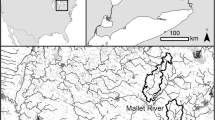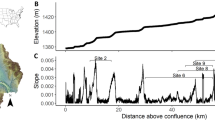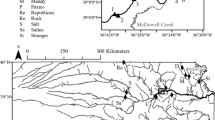Abstract
Quantifying the spatial and temporal dynamics of stream metabolism across stream networks is key to understanding carbon cycling and stream food web ecology. To better understand intra-annual temporal patterns of gross primary production (GPP) and ecosystem respiration (ER) and their variability across space, we continuously measured dissolved oxygen and modeled stream metabolism for an entire year at ten sites across a temperate river network in Washington State, USA. We expected GPP and ER to increase with stream size and peak during summer and autumn months due to warmer temperatures and higher light availability. We found that GPP and ER increased with drainage area and that only four sites adhered to our expectations of summer peaks in GPP and autumn peaks in ER while the rest either peaked in winter, spring or remained relatively constant. Our results suggest the spatial arrangement and temporal patterns of discharge, temperature, light and nutrients within watersheds may result in asynchronies in GPP and ER, despite similar regional climatic conditions. These findings shed light on how temporal dynamics of stream metabolism can shift across a river network, which likely influence the dynamics of carbon cycling and stream food webs at larger scales.







Similar content being viewed by others
References
Aboal M, Marco S, Chaves E, Mulero I, García-Ayala A (2012) Ultrastructure and function of stalks of the diatom Didymosphenia geminata. Hydrobiologia 695:17–24
APHA (2005) Standard methods for the examination of water and wastewater, 21st edn. American Public Health Association, Washington, DC
Aristegi L, Izagirre O, Elosegi A (2009) Comparison of several methods to calculate reaeration in streams, and their effects on estimation of metabolism. Hydrobiologia 635:113–124
Bartoń K (2015) MuMIn: multi-model inference. R package version 1.15.1
Beaulieu JJ, Arango CP, Balz DA, Shuster WD (2013) Continuous monitoring reveals multiple controls on ecosystem metabolism in a suburban stream. Freshw Biol 58:918–937
Bellmore JR, Baxter CV (2014) Effects of geomorphic process domains on river ecosystems: a comparison of floodplain and confined valley segments. River Res Appl 30:617–630
Bellmore JR, Fremier AK, Mejia F, Newsom M (2014) The response of stream periphyton to Pacific salmon: using a model to understand the role of environmental context. Freshw Biol 59:1437–1451. https://doi.org/10.1111/fwb.12356
Benjamin JR, Bellmore JR, Watson GA (2016) Response of ecosystem metabolism to low densities of spawning Chinook Salmon. Freshw Sci 35:810–825
Bergey EA, Getty GM (2006) A review of methods for measuring the surface area of stream substrates. Hydrobiologia 556:7–16
Bernhardt ES, Heffernan JB, Grimm NB, Stanley EH, Harvey JW, Arroita M, Appling AP, Cohen MJ, McDowell WH, Hall RO, Read JS, Roberts BJ, Stets EG, Yackulic CB (2017) The metabolic regimes of flowing waters. Limnol Oceanogr 63:S99–S118. https://doi.org/10.1002/lno.10726
Bernot MJ, Sobota DJ, Hall RO, Mulholland PJ, Dodds WK, Webster JR, Tank JL, Ashkenas LR, Cooper LW, Dahm CN, Gregory SV, Grimm NB, Hamilton SK, Johnson SL, McDowell WH, Meyer JL, Peterson B, Poole GC, Valett HM, Arango C, Beaulieu JJ, Burgin AJ, Crenshaw C, Helton AM, Johnson L, Merriam J, Niederlehner BR, O’Brien JM, Potter JD, Sheibley RW, Thomas SM, Wilson K (2010) Inter-regional comparison of land-use effects on stream metabolism. Freshw Biol 55:1874–1890
Biedenharn DS, Copeland RR, Thorne CR, Soar PJ, Hey RD, Watson CC (2000) Effective discharge calculation: a practical guide. Technical Rep. No. ERDC/CHL TR-00-15, U.S. Army Corps of Engineers, Washington, D.C. 48 pp
Bothwell ML, Taylor BW, Kilroy C (2014) The Didymo story: the role of low dissolved phosphorus in the formation of Didymosphenia geminata blooms. Diatom res 29:229–236
Demars BOL, Thompson J, Manson JR (2015) Stream metabolism and the open diel oxygen method: principles, practice and perspectives. Limnol Oceanogr Meth 13:356–374
Dodds WK. Higgs SA, Spangler MJ, Guinnip J, Scott JD, Hedden SC, Frenette BD, Taylor R, Schechner AE, Hoeinghaus DJ, Evans-White MA (2018) Spatial heterogeneity and controls of ecosystem metabolism in a Great Plains river network. Hydrobiologia 1:85–102
Ensign SH, Doyle MW (2006) Nutrient spiraling in streams and river networks. J Geophys Res Biogeosci 111:1–13
Finlay JC (2011) Stream size and human influences on ecosystem production in river networks. Ecosphere 2:art87. https://doi.org/10.1890/ES11-00071.1
Finlay JC, Hood JM, Limm MP, Power ME, Schade JD, Welter JR (2011) Light-mediated thresholds in stream-water nutrient composition in a river network. Ecology 92:140–150
Gordon ND, McMahon TA, Finlayson BL, Gippel CJ, Nathan RJ (2004) Stream hydrology: an introduction for ecologists, 2nd edn. Wiley, Chichester, England, p 429 (ISBN: 978-0-470-84358-1)
Grace MR, Imberger SJ (2006) Stream metabolism: Performing & interpreting measurements. Water Studies Centre Monash University, Murray Darling Basin Commission and New South Wales Department of Environment and Climate Change
Grace MR, Giling DP, Hladyz S, Caron V, Thompson RM, McNally R (2015) Fast processing of diel oxygen curves: estimating stream metabolism with BASE (BAyesian Single-station Estimation). Limnol Oceanogr-Meth 13:103–114
Greenwood JL, Rosemond AD (2005) Periphyton response to long-term nutrient enrichment in a shaded headwater stream. Can J Fish Aquat Sci 62:2033–2045
Griffiths NA, Hill WR (2014) Temporal variation in the importance of a dominant consumer to stream nutrient cycling. Ecosystems 17:1169–1185
Griffiths NA, Tank JL, Royer TV, Roley SS., Rosi-Marshall EJ, Whiles MR, Beaulieu JJ, Johnson LT (2013) Agricultural land use alters the seasonality and magnitude of stream metabolism, Limnol Oceanogr. https://doi.org/10.4319/lo.2013.58.4.1513
Hall RO, Hotchkiss ER (2017) Stream metabolism. In: Hauer FR, Lamberti GA (eds) Methods in stream ecology, volume 2, 3rd edn. Academic Press, Cambridge, pp 219–233
Hall RO, Tank JL (2003) Ecosystem metabolism controls nitrogen uptake in streams in the Grand Teton National Park, Wyoming. Limnol Oceanogr 48:1120–1128
Hall RO, Kennedy TA, Rosi-Marshall EJ (2012) Air–water oxygen exchange in a large, whitewater river. Limnol Oceanogr Fluids Environ 2:1–11. https://doi.org/10.1215/21573689-1572535
Hall RO, Tank JL, Baker MA, Rosi-Marshall EJ, Hotchkiss ER (2016) Metabolism, gas exchange, and carbon spiraling in rivers. Ecosystems 19:73–86
Hart AM (2013) Seasonal variation in whole stream metabolism across varying land use types. Masters thesis. Virginia Polytechnic Institute and State University. Blacksburg, Virginia, USA
Hoellein TJ, Bruesewitz DA, Richardson DC (2013) Revisiting Odum (1956): a synthesis of aquatic ecosystem metabolism. Limnol Oceanogr 58:2089–2100
Hotchkiss ER, Hall RO Jr (2015) Whole-stream 13C tracer addition reveals distinct fates of newly fixed carbon. Ecology 96:403–416
Izaguirre O, Agirre U, Bermejo M, Pozo J, Elosegi A (2008) Environmental controls of whole-stream metabolism identified from continuous monitoring of Basque streams. J N Am Benthol Soc 27:252–268
Julian JP, Doyle MW, Stanley EH (2008) Empirical modeling of light availability in rivers. J Geophys Res 113:G03022. https://doi.org/10.1029/2007JG000601
Kendrick MR, Huryn AD (2015) Discharge, legacy effects and nutrient availability as determinants of temporal patterns in biofilm metabolism and accrual in an arctic river. Freshw Biol 60:2323–2336
Konrad CP (2006) Location and timing of river-aquifer exchanges in six tributaries to the Columbia River in the Pacific Northwest of the United States. J Hydrol 329:444–470
Lamberti GA, Steinman AD (1997) A comparison of primary production in stream ecosystems. J N Am Benthol Soc 16:95–103
Leopold LB (1994) A view of the river. Harvard University Press, Cambridge,
Levin SA (1992) The problem of pattern and scale in ecology. Ecology 73:1943–1967
Marcarelli AM, Van Kirk RW, Baxter CV (2010) Predicting effects of hydrologic alteration and climate change on ecosystem metabolism in a western U.S. river. Ecol Appl 20:2081–2088
McCutchan JH, Lewis WM, Saunders JF, Saunders (1998) Uncertainty in the estimation of stream metabolism form open-channel oxygen concentrations. J N Am Benthol Soc 17:155–164
McIntyre PB, Flecker AS, Vanni MJ, Hood JM, Taylor BW, Thomas SA (2008) Fish distributions and nutrient cycling in streams: can fish create biogeochemical hotspots. Ecology 89:2335–2346
Minshall GW, Shafii B, Price WJ, Holderman C, Anders PJ, Lester G, Barrett P (2014) Effects of nutrient replacement on benthic macroinvertebrates in an ultraoligotrophic reach of the Kootenai River, 2003–2010. Freshw Sci 33:1009–1023
Moore JW, McClure M, Rogers LA, Schindler DE (2010) Synchronization and portfolio performance of threatened salmon. Conserv Lett 3:340–348
Moore J, Beakes MP, Nesbitt HK, Yeakel JD, Patterson DA, Thompson LA, Phillis CC, Braun DC, Favaro C, Scott D, Carr-Harris C, Atlas WI (2015) Emergent stability in a large, free-flowing watershed. Ecology 96:340–347
Odum HT (1956) Primary production in flowing waters. Limnol Oceanogr 1:102–117
Ogdahl ME, Lougheed VL, Stevenson RJ, Steiman AD (2010) Influences of multi-scale habitat on metabolism in a coastal Great Lakes watershed. Ecosystems 13:222–238
Pinheiro JC, Bates DM, DebRoy S, Sarkar DR Core Team (2017) nlme:linear and nonlinear mixed effects models_R package version 3.1–131
Piontek J, Händel N, De Bodt C, Harlay J, Chou L, Engel A (2011) The utilization of polysaccharides by heterotrophic bacterioplankton in the Bay of Biscay (North Atlantic Ocean). J Plankton Res 33:1719–1735
R Development Core Team (2013) R: a language and environment for statistical computing. R Foundation for Statistical Computing, Vienna, Austria. R 2.15.2 GUI
Roberts BJ, Mulholland PJ, Hill WR (2007) Multiple scales of temporal variability in ecosystem metabolism rates: results from 2 years of continuous monitoring in a forested headwater stream. Ecosystems 10:588–606
Romaní AM, Sabater S (2000) Variability of heterotrophic activity in Mediterranean stream biofilms: a multivariate analysis of physical–chemical and biological factors. Aquat Sci 62:205–215
Rosemond AD (1994) Multiple factors limit seasonal variation in periphyton in a forest stream. J N Am Benthol Soc 13:333–344
Saunders WC, Bouwes N, McHugh P, Jordan CE (2018) A network model for primary production highlights linkages between salmonid populations and autochthonous resources. Ecosphere 9:e02131. https://doi.org/10.1002/ecs2.2131
Schindler DE, Armstrong JB, Reed TE (2015) The portfolio concept in ecology and evolution. Front Ecol Environ 13:257–263
Song C, Dodds WK, Trentman MT, Ruegg J, Ford B (2016) Methods of approximation influence aquatic ecosystem, metabolism estimates. Limnol Oceanogr-Meth 14:557–569
Steel EA, Beechie TJ, Torgersen CE, Fullerton AH (2017) Envisioning, quantifying, and managing thermal regimes on river networks. Bioscience 67:506–522
Tank J, Rosi-Marshall E, Griffiths NA, Entrekin SA, Stephen ML (2010) A review of allochthonous organic matter dynamics and metabolism in streams. J N Am Benthol Soc 29:118–146
Townsend SA, Webster IT, Schult JH (2011) Metabolism in a groundwater-fed river system in the Australian wet/dry tropics: tight coupling of photosynthesis and respiration. J N Am Benthol Soc 30:603–620
Uehlinger U (2006) Annual cycle and inter-annual variability of gross primary production and ecosystem respiration in a floodprone river during a 15-year period. Freshw Biol 51:938–950
Uehlinger U, Naegeli MW (1998) Ecosystem metabolism, disturbance, and stability in a prealpine gravel bed river. J N Am Benthol Soc 17:165–178
Ulseth AJ, Bertuzzo E, Singer GA et al (2018) Climate-induced changes in spring snowmelt impact ecosystem metabolism and carbon fluxes in an alpine stream network. Ecosystems 21: 373–390 https://doi.org/10.1007/s10021-017-0155-7
Val J, Chinarro D, Pino MR, Navarro E (2016) Global change impacts on river ecosystems: a high-resolution watershed study of Ebro river metabolism. Sci Tot Environ 570:774–783
Valett HM, Thomas SA, Mulholland PJ, Webster JR, Dahm CN, Fellows CS, Crenshaw CL, Peterson CG (2008) Endogenous and exogenous control of ecosystem function: N cycling in headwater streams. Ecology 89:3515–3527
Venkiteswaran JJ, Schiff SL, Taylor WD (2015) Linking aquatic metabolism, gas exchange, and hypoxia to impacts along the 300-km Grand River, Canada. Freshw Sci 34:1216–1232
Walter JA, Sheppard LW, Anderson TL, Kastens JH, Bjornstad ON, Liebhold AM, Reuman DC (2017) The geography of asynchrony. Ecol Lett 20:801–814
Wellnitz T, Rader RB (2003) Mechanisms influencing community composition and succession in mountain stream periphyton: interactions between scouring history, grazing, and irradiance. J N Am Benthol Soc 22:528–541
Wetzel RG (2001) Limnology: lake and river ecosystems. Academic Press, San Diego
Yates AG, Brua RB, Culp JM, Chambers PA (2013) Multi-scaled drivers of rural prairie stream metabolism along human activity gradients. Freshw Biol 58:675–689
Young RG, Huryn AD (1996) Interannual variation in discharge controls ecosystem metabolism along a grassland river continuum. Can J Fish Aquat Sci 53:2199–2211
Zuckerman A (2015) Seasonal variation in empirical and modeled periphyton at the watershed scale. Masters thesis. University of Idaho, Moscow, Idaho, USA
Zuur AF, Ieno EN, Walker N, Saveliev AA, Smith GM (2009) Mixed effects models and extensions in ecology with R. Springer, New York
Acknowledgements
The research was supported by the US Bureau of Reclamation Cooperative Agreement to Dr. A. Fremier at the University of Idaho and Washington State University, Project Numbers # R11AC17061 and # R15AC00005. Eric Berntsen helped with the daily discharge estimates. This paper was improved with critical reviews by Dr. Colden Baxter (Idaho State University), Dr. Chris Caudill (University of Idaho), and members of the Fremier Lab (Washington State University). Any use of trade, product, or firm names is for descriptive purposes only and does not imply endorsement by the U.S. Government.
Author information
Authors and Affiliations
Corresponding author
Ethics declarations
Conflict of interest
The authors declare that they have no conflict of interest.
Rights and permissions
About this article
Cite this article
Mejia, F.H., Fremier, A.K., Benjamin, J.R. et al. Stream metabolism increases with drainage area and peaks asynchronously across a stream network. Aquat Sci 81, 9 (2019). https://doi.org/10.1007/s00027-018-0606-z
Received:
Accepted:
Published:
DOI: https://doi.org/10.1007/s00027-018-0606-z




